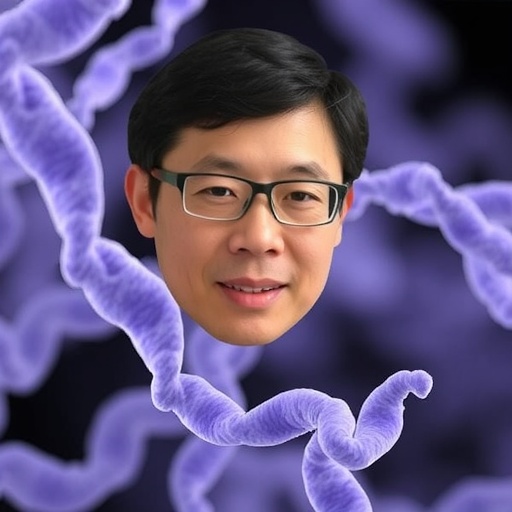In the realm of molecular biology and biophysics, one of the most enigmatic yet essential proteins—collagen—has long defied complete understanding. Researchers at Simon Fraser University are now illuminating new facets of this protein’s behavior, particularly its remarkable ability to maintain structural integrity despite its inherent instability at physiological temperatures. This groundbreaking research, led by physics professor Nancy Forde and postdoctoral fellow Alaa Al-Shaer, reveals the molecular mechanisms that enable collagen to withstand thermal fluctuations and offers fresh insight into its folding and unfolding behavior. Their findings, recently published in the prestigious Proceedings of the National Academy of Sciences, open new avenues for understanding diseases linked to collagen deficiencies and structural weaknesses.
Collagen comprises roughly 20 percent of all proteins in the human body, serving as a primary component of connective tissues including tendons, bones, cartilage, and skin. It acts not only as a structural support but as a dynamic scaffold facilitating cellular growth and function. This dual role underscores the importance of its molecular stability, which has puzzled scientists for decades: how can collagen remain functional and maintain its architecture at human body temperature when its molecular structure is known to be inherently unstable?
The key to this puzzle lies in collagen’s infamous triple-helix architecture—three polypeptide strands intricately twisted into a rope-like formation. This conformation confers mechanical strength under normal physiological conditions. However, when subjected to increased thermal energy, these helices tend to “unravel” into less ordered, random coils, compromising their functional integrity. Understanding precisely how collagen threads transition between these folded and unfolded states—and crucially, how they refold upon cooling—has been a central challenge in collagen biophysics.
To investigate these processes at the molecular level, Alaa Al-Shaer employed atomic force microscopy (AFM), a technique capable of producing nanoscale images by “feeling” the surface topology of biomolecules with an ultra-fine probe tip. Unlike traditional optical microscopy, which lacks the resolution to visualize individual collagen molecules, AFM offers a direct glimpse into the structural dynamics of these proteins under varying thermal conditions. This innovative application allowed the team to capture hundreds of images of collagen IV molecules as they responded to precise temperature changes, mapping their unfolding and refolding pathways in unprecedented detail.
One of the most striking findings emerging from this study was the critical role of cysteine residues within collagen IV. These amino acids act as molecular staples by forming covalent bonds—known as disulfide bridges—between individual collagen strands. These inter-strand bonds effectively “lock” parts of the triple helix together, markedly increasing the protein’s resistance to thermal denaturation. The presence of these cysteine-mediated crosslinks meant that collagen IV could withstand greater heat stress without irreversible unraveling, and upon cooling, was more likely to recover its native triple-helix configuration.
Conversely, collagen molecules lacking such stabilizing cysteine bonds exhibited a pronounced propensity to lose their helical structure upon heating and failed to refold correctly when cooled. This differentiation underscores the functional importance of cysteine residues in maintaining collagen stability and self-repair mechanisms at the molecular level. These observations suggest a delicate balance of molecular interactions that enable collagen to perform robustly under fluctuating physiological conditions.
Further bioinformatic investigations revealed that these cysteine “staples” do not represent a recent evolutionary adaptation but are, in fact, conserved across diverse multicellular organisms, some of which diverged hundreds of millions of years ago. This evolutionary conservation points to a vital functional role, as any substitution of these cysteines with other amino acids would likely compromise the protein’s thermal resilience, something apparently avoided in nature’s molecular design.
This work represents the first application of atomic force microscopy to chart the temperature-dependent folding landscape of full-length collagen molecules. Previous studies often resorted to examining short synthetic collagen peptides, which, while informative, may not capture the complexity of the entire protein sequence and its interactions. By studying native-length collagen molecules, the SFU team’s approach addresses this gap, providing data that can validate or challenge existing models derived from peptide studies.
Professor Forde emphasizes the potential of this methodological advance to raise new questions and deepen our understanding of collagen-related phenomena. She notes that the AFM technique not only clarifies how normal collagen behaves under thermal stress but also paves the way to exploring pathological mutations and chemical modifications found in a variety of diseases such as brittle bone disease (osteogenesis imperfecta), Ehlers-Danlos Syndrome, and the impacts of diabetes-related collagen alterations.
The SFU team is enthusiastic about the future of their research platform. Graduate and undergraduate students have played an instrumental role in advancing these investigations, signaling a bright horizon of collaborative discovery and innovation. The group is particularly interested in employing AFM to study mutated collagen variants and chemically altered forms associated with aging and disease, aiming to elucidate mechanisms that underlie tissue degeneration and fragility.
Looking ahead, such research promises significant ramifications not only for basic science but also for clinical applications. A refined molecular understanding of collagen stability and repair mechanisms could inform the design of targeted therapeutics and tissue engineering strategies. These advances might ultimately improve treatments for a spectrum of connective tissue disorders, enhancing patient outcomes through precisely tailored interventions.
The work by Forde, Al-Shaer, and their colleagues heralds an exciting chapter in the molecular exploration of collagen, uniting advanced imaging techniques with biochemical insights. By decoding the thermal unfolding and refolding pathways of collagen at the single-molecule level, they are unraveling one of nature’s intricate puzzles—transforming our grasp of protein stability from theoretical speculation into visualized reality.
Subject of Research: Molecular mechanisms underlying collagen stability and the thermal unfolding/refolding pathways of collagen IV.
Article Title: Decoding collagen’s thermally induced unfolding and refolding pathways
Web References:
http://dx.doi.org/10.1073/pnas.2420308122
References:
Forde, N., & Al-Shaer, A. (2024). Decoding collagen’s thermally induced unfolding and refolding pathways. Proceedings of the National Academy of Sciences. https://www.pnas.org/doi/10.1073/pnas.2420308122
Keywords
Life sciences, Biochemistry, Collagen stability, Atomic force microscopy, Triple-helix proteins, Thermal unfolding, Protein folding, Connective tissue proteins, Molecular biophysics




